The Islamic State’s Amaq News Agency releases an infographic summarizing the total number of “martyrdom operations” (suicide attacks) carried out by its followers each month. The latest infographic, which was released yesterday and can be seen below, indicates that 132 suicide bombings were launched in Iraq and Syria during the month of November.
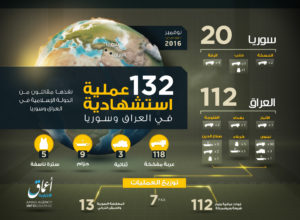
Via Amaq’s infographics, the Islamic State has now claimed responsibility for a staggering 1,034 suicide attacks through the first eleven months of 2016. In addition to Iraq and Syria, some of these took place in Libya.
The battle for Mosul
The overwhelming majority of these have been carried out inside Iraq, where the Islamic State is trying to hold its territory.
During the month of November, for example, 112 (or 85 percent) of the claimed suicide bombers were detonated in Iraq, with 94 occurring in the Nineveh province alone. The US military, Iraqi government, Kurdish forces, Iranian-backed militias and others launched an offensive to retake Mosul, which is located in Nineveh, in October. Amaq’s infographic for November is the latest piece of evidence indicating that the Islamic State is relying on a large number of suicide bombers to defend the city.
Amaq previously claimed that the so-called caliphate deployed 79 suicide bombers in Nineveh province in October.
In addition, Amaq has released infographics commemorating each of the first seven weeks of the battle for Mosul. The first three of these were previously reproduced by The Long War Journal. The remaining four can be seen below.
According to these statistics, 182 suicide bombers have been dispatched in and around Mosul during the first seven weeks of fighting.
[For more on the Islamic State’s “martyrdom operations” during the battle for Mosul, see FDD’s Long War Journal report: Islamic State defends Mosul with dozens of suicide bombers.]
Claiming suicide bombings at a historically high rate
As The Long War Journal has previously reported, the Islamic State claims to be carrying out suicide bombings at a historically high rate in 2016.
Amaq’s infographics indicate that the group has launched an average of 94 “martyrdom operations” in Iraq, Libya and Syria per month (1,034 in total) from January through November.
According to open source data compiled by the National Consortium for the Study of Terrorism and Responses to Terrorism (START), all terrorist organizations around the globe carried out 906 (76 per month) suicide attacks in 2015 and 739 (62 per month) in 2014. The year 2015 was the previous high water mark for suicide bombings. Many of those attacks in 2014 and 2015 were orchestrated by the Islamic State, but other organizations’ “martyrs” are included in the totals as well.
Therefore, the Islamic State’s figures suggest that the organization is setting a new record for suicide bombings in 2016 all by itself.
However, there are important caveats to keep in mind when assessing Amaq’s claims.
First, it is not possible to validate the total figures provided by Amaq. The Islamic State propaganda arm does post individual claims for most, if not all, of the “martyrdom operations” tallied on its infographics. These statements indicate a specific location and target for each “martyr,” but this is not independent verification as it comes from the same source (Amaq). Furthermore, while open source reporting documents many such operations, it is unlikely that all of the suicide attacks are tracked in publicly-available sources. The fog of war often makes it difficult to document precise details.
The identities of many of these attackers are not known. The Islamic State has used children or adolescents in at least some of its “martyrdom operations.” Such young people cannot be truly considered willing “martyrs.”
Some suicide bombers fail to reach their intended targets, but are probably included in Amaq’s tally anyway. Press reports have detailed how many Islamic State operatives fail to hit their mark prior to blowing themselves up. The US and its allies often destroy vehicle-borne improvised explosive devices (VBIEDs) before they can do any damage.
It is also possible that Amaq exaggerates the efficacy of the group’s “martyrdom operations” by overstating the casualties caused and the total number of targets destroyed (including enemy vehicles) in the resulting explosions.
Many of the Islamic State’s suicide bombings are defensive in nature, meaning that a large number of “martyrs” are being deployed as the caliphate’s grip on territory slips.
In addition, suicide attacks are just one of the many tactics employed by the Islamic State.
Still, there is no question that the Islamic State is relying on suicide bombers at a remarkable pace. And if Amaq’s data are accurate, then November saw more suicide bombings by Abu Bakr al Baghdadi’s operation (132) than in any previous month this year. The previous high for 2016 came in October, when 120 “martyrdom operations” were carried out in Iraq, Libya and Syria. September witnessed the fewest suicide attacks with 53, according to Amaq.
Amaq News Agency’s infographics for weeks four through seven of the battle for Mosul:
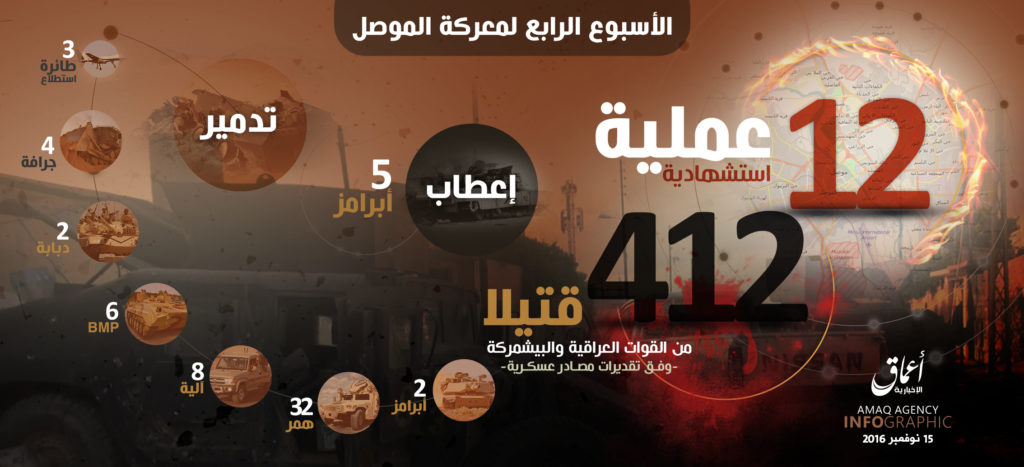
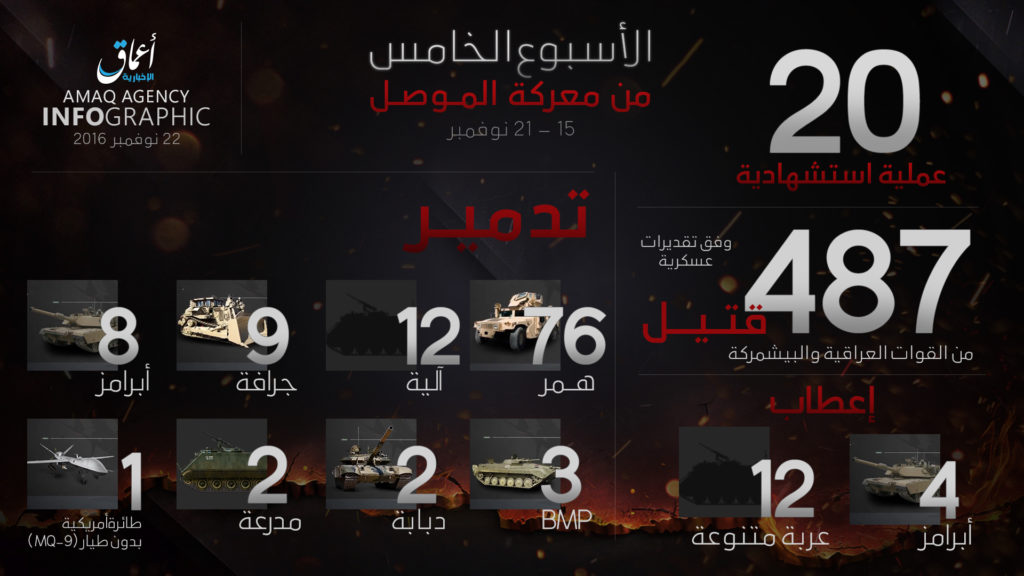
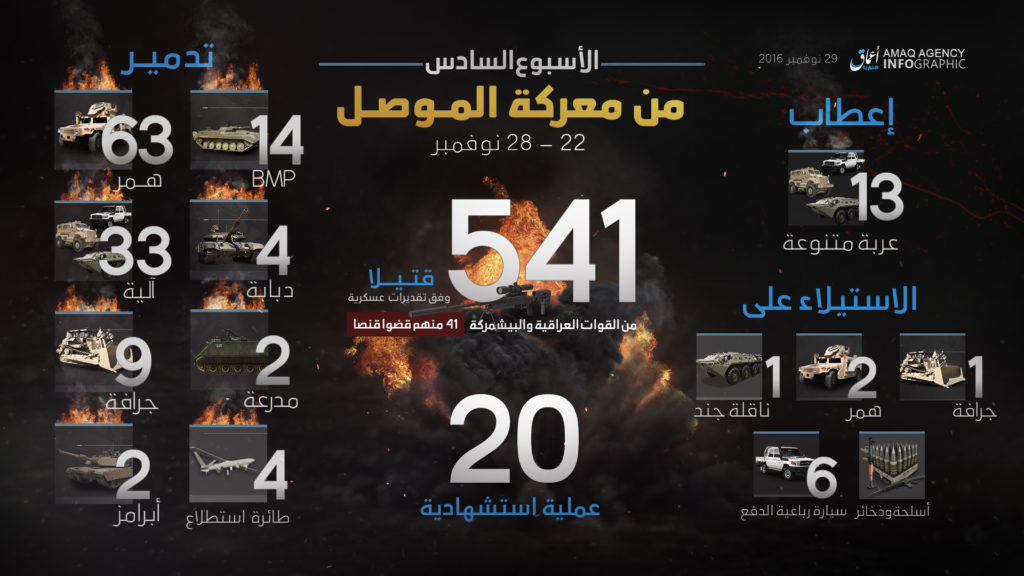
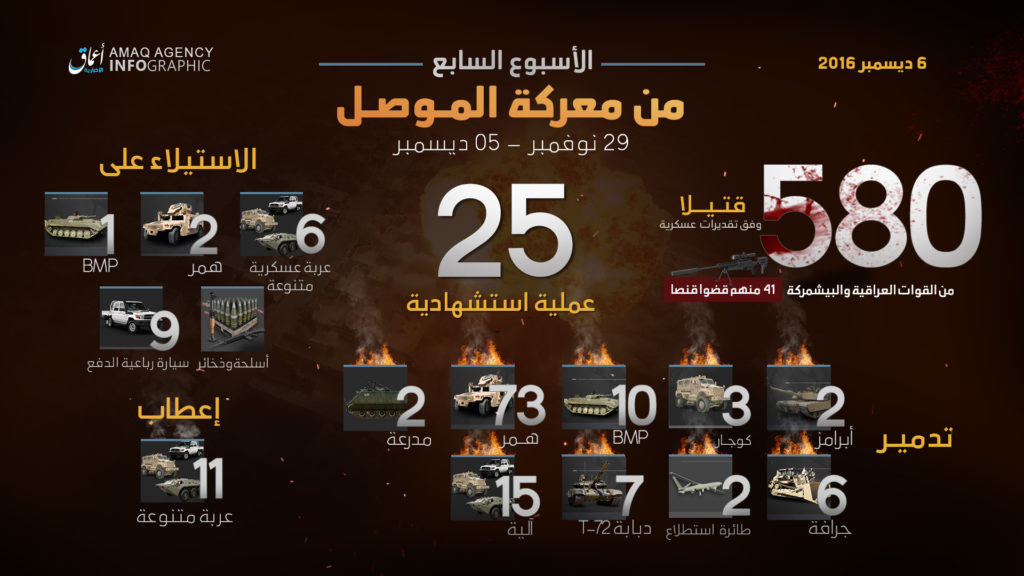








3 Comments
THE FAVORITE/TACTIC OF THE ISLAMIC STATE THE SUICIDE BOMBER.
In the past, other countries have gone the martyr route, only to lose the war in the end. One should not be considered a martyr or holy warrior when they go around blowing up soft targets. It is becoming at act of desperation , proving nothing except that the leaders who force others to perform these acts, are mere low grade vile degenerates. But as long as there
are a plethora of weapons and arms dealers, we will continue to see these kind of activities
on different scales for some time. Better intel is needed and this current war should provide
a learning experience for intel operations to track arms sales , those that sell and those who
receive.
Good Morning Thomas,
I find your analysis detailed, supported and spot on. Thank you. Is there any way to have the Amaq graphics translated into English. Unfortunately, I do not have a translator yet so I’d be curious to see how they break out their categories.
Respectfully, Dan